Alpine ibex
The Alpine ibex (Capra ibex), also known as the steinbock, bouquetin, or simply ibex, is a species of wild goat that lives in the mountains of the European Alps. It is a sexually dimorphic species: males are larger and carry longer, curved horns than females. Its coat colour is typically brownish grey. Alpine ibex tend to live in steep, rough terrain near the snow line. They are also social, although adult males and females segregate for most of the year, coming together only to mate. Four distinct groups exist; adult male groups, female-offspring groups, groups of young individuals, and mixed-sex groups.
| Alpine ibex | |
|---|---|
_Zoo_Salzburg_2014_h.jpg.webp) | |
| Male | |
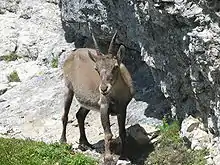 | |
| Female | |
| Scientific classification | |
| Domain: | Eukaryota |
| Kingdom: | Animalia |
| Phylum: | Chordata |
| Class: | Mammalia |
| Order: | Artiodactyla |
| Family: | Bovidae |
| Subfamily: | Caprinae |
| Tribe: | Caprini |
| Genus: | Capra |
| Species: | C. ibex |
| Binomial name | |
| Capra ibex | |
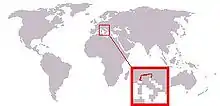 | |
| Range map in the Alps | |
During the breeding season, males fight for access to females, and use their long horns in agonistic behaviour. After being extirpated from most areas by the 19th century, the Alpine ibex was successfully reintroduced to parts of its historical range. All individuals living today descend from the stock in Gran Paradiso National Park in Aosta Valley and Piedmont (Italy), a national park created to help the ibex thrive. The ibex is the emblem of both the Gran Paradiso National Park, and the contiguous Vanoise National Park across the French border. The species is currently listed as of least concern by the IUCN, but went through a population bottleneck of fewer than 100 individuals during its near-extinction event. This has led to very low genetic diversity across populations.
Taxonomy
The Alpine ibex was first described by Carl Linnaeus in 1758. It is classified in the genus Capra (Latin for "goat") with at least seven other species of wild goats. Both Capra and Ovis (sheep) descended from a goral-like animal from the Miocene and early Pliocene, whose fossils are found in Kenya, China, and Slovenia. Fossils of the genus Tossunnoria is found in late Miocene deposits in China and appears to have been a transitional fossil between goats and their ancestors.[2]
The genus Capra may have originated in Central Asia and colonized Europe, the Caucasus, and East Africa from the Pliocene and into the Pleistocene. Mitochondrial and Y chromosome evidence show hybridisation of species in the linage.[3] Fossils of Alpine ibex date back to the late Pleistocene (during in the last glacial period), with the Spanish ibex and it probably evolved from the extinct Pleistocene species Capra camburgensis.[2] The Nubian (C. nubiana), walia (C. walie), and Siberian ibexes (C. sibirica) were considered to be subspecies of the Alpine ibex in the 20th century, giving populations in the Alps the trinomial of C. i. ibex.[4] Subsequent genetic evidence has supported them as separate species.[3]
The following cladogram is based on mitogenomic evidence:[5]
| Caprinae |
| ||||||||||||||||||||||||||||||||||||||||||
Appearance
Compared with most other wild goats, the Alpine ibex has a wide, and shortened snout. Males commonly grow to a height of 90 to 101 cm (35 to 40 in) at the withers, with a body length of 149 to 171 cm (59 to 67 in) and weigh from 67 to 117 kg (148 to 258 lb). Females are noticeably smaller, with a shoulder height of 73 to 84 cm (29 to 33 in), a body length of 121 to 141 cm (48 to 56 in), and a weight of 17 to 32 kg (37 to 71 lb). Both male and female Alpine ibex have large, backwards-curving horns with numerous horizontal ridges along their length. At 69 to 98 cm (27 to 39 in), those of the males are substantially larger than those of females, which reach only 18 to 35 cm (7.1 to 13.8 in) in length.[2]
The species has brownish-grey hair over most of the body, lighter on the belly, with darker markings on the chin and throat. The hair on the chest region is nearly black while stripes exist along the dorsal (back) surface. It is duller coloured than other members of its genus. A beard exists only in males. They moult in spring, when their thick winter coat, consisting of woolly underfur, is replaced with a short, thin summer coat. Their winter coat grows back again starting in the fall. Alpine ibex are able to climb vertical surfaces with the aid of a callus located at each carpal joint.[2]
Distribution and habitat
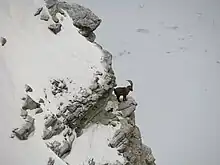
The alpine ibex is native to the Alps mountains, its range including France, Switzerland, Italy, Germany, Austria and Slovenia.[2] Fossils of the species have been found as far south as Greece, where they appear to have gone extinct due to hunting over 7,500 years ago.[6] An excellent climber, its preferred habitat is the rocky region along the snow line above alpine forests, where it occupies steep, rough terrain at elevations of 1,800 to 3,300 m (5,900 to 10,800 ft).[7]
Alpine ibex prefer to live an open areas,[2] but when there is little snow, adult males may gather in larch and mixed larch-spruce woodland depending on population density.[8] Outside the breeding season, the sexes live in separate habitats.[8][9] Females are more likely to be found on steep slopes while males prefer more level ground. Males inhabit lowland meadows during the spring, when fresh grass appears.[2] They then climb to alpine meadows during the summer.[8] Both males and females move to steep, rocky slopes when winter arrives to getting snuck in dense buildups of snow.[10] They prefer slopes of 30–45° and take refuge in small caves and overhangs.[11]
Behaviour and life history
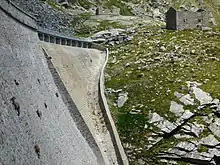
Alpine ibex are strictly herbivorous, with over half of their diet consisting of grasses, and the remainder being a mixture of mosses, flowers, leaves, and twigs. Grass genera that are the most commonly eaten are Agrostis, Avena, Calamagrostis, Festuca, Phleum, Poa, Sesleria, and Trisetum.[2]
Home ranges are highly variable, depending on the availability of resources, and vary in size throughout the year. Figures from 180 to 2,800 ha (0.69 to 10.81 sq mi) have been recorded.[2][10] Home ranges tend to be largest during summer and autumn, smallest in winter, and intermediate in spring.[2] Female home ranges are usually smaller than those of males. Alpine ibex appear to have a low rate of predation and in Gran Paradiso typically die of age, starvation, or disease.[2]
The climbing ability of the Alpine ibex is such that it has been observed climbing up the Cingino Dam in Piedmont, Italy, where it licks the artificial salts. Only females and young (kids) will scale the steep dam due to their lighter weight and shorter legs. Kids have been recorded to reach heights of 49 m (161 ft), ascending in a zig-zag path on gradients of up to 155% while descending in straight lines at 157% gradients. They move along the dam by walk and galloping.[12]
Group organisation
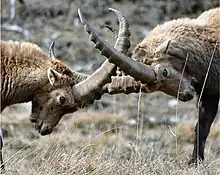
Although the Alpine ibex is a social species, they segregate sexually and spatially depending on the season.[2] Four types of groups exist: Adult male groups, female-offspring groups, groups of young individuals 2–3 years old, and mixed-sex groups.[2][13] Young groups are numerous at the beginning of summer, but are expelled by females at the end of their gestation period. Female and offspring groups occur year-round, at least in an area of the French Alps.[13] Mixed-sex groups of adult males and females occur during breeding, which lasts from December to January. By April and May, the adults separate.[13] The largest aggregations of either sex occur during June and July. Gatherings of males begin to decrease during October and November, and are lowest from the rut from December to March.[13] The males then leave their separate wintering areas and gather again.[14]
A linear dominance hierarchy exists among males. In small populations, which are more cohesive, males know their place in the hierarchy based on memories of past encounters,[2] while in mobile and large groups, where encounters with strangers are common, rank is based on horn size.[15] Antagonistic behavior in males can come in the form of "direct" or "indirect" aggression. With direct aggression, one male bumps another with his horns or places himself in front of his opponent. He stands on his hind legs and comes down on his opponent with his horns. This may signal that he is ready to clash or may be attempting a real clash.[2] Indirect aggression is mostly intimidation displays.[2]
Reproduction and growth

The breeding season starts in December, and typically lasts around six weeks. During this time, male herds break up into smaller groups that search for females. The rut takes place in two phases. In the first phase, the male groups interact with the females that are all in oestrous. The higher the male's rank, the closer he can get to a female.[2] Males perform courtship displays. In the second phase of the rut, one male separates from his group to follow an individual female. He displays to her and guards her from other males. Before copulation, the female moves her tail and courtship becomes more intense. They copulate and then he rejoins his group and reverts to the first phase.[2] Gestation lasts around 167 days, and results in the birth of one or two kids, with twins making up about 20% of births.[16]
Alpine ibex reach sexual maturity at 18 months, but females do not reach their maximum body size for five to six years, and males not for 9–11 years. The horns grow throughout life, growing most rapidly during the second year of life, and thereafter by about 8 cm (3.1 in) a year, eventually slowing to half that rate once the animal reaches 10 years of age. Alpine ibex live for up to 19 years in the wild.[17]
Conservation status

The Alpine ibex historically ranged through France, Italy, Switzerland, Liechtenstein, Bavaria, Austria and Slovenia. Starting in the early 16th century and with firearms becoming common, the overall population declined due to overexploitation and poaching. The ibex became extirpated in Switzerland and Germany by the 18th century, and was extirpated in Austria and northeastern Italy by the 19th century. They remained only in and around the adjacent Gran Paradiso and Vanoise Massifs, then both part of the Kingdom of Sardinia. Located in the western Italian Alps and the Maurienne valley in the north eastern French alps, bordering the Vanoise and Gran Paradiso Massif, the park was declared a royal hunting reserve in 1854 with the name of "Royal hunting reserve of Gran Paradiso" by Victor Emmanuel II, the first king of a united Italy.[18]
Ibex were protected from poaching and their numbers increased, reaching 3,020 in 1914. The ibex enjoyed further protection when Gran Paradiso was made into a national park in 1922. Animals from this population naturally dispersed into surrounding regions. However, reintroductions have been the predominant source of new populations. Today, the total population of Alpine ibex is over 30,000 and is considered to be of Least Concern by the IUCN. However, Alpine ibex have low genetic diversity putting them at risk of inbreeding depression.[1][19] A 2020 analysis found that highly deleterious mutations were lost in these new populations but they but also gained mildly deleterious ones.[20]
References
- Toïgo, C.; Brambilla, A.; Grignolio, S.; Pedrotti, L. (2020). "Capra ibex". IUCN Red List of Threatened Species. 2020: e.T42397A161916377. doi:10.2305/IUCN.UK.2020-2.RLTS.T42397A161916377.en. Retrieved 19 November 2021.
- Parrini, F.; Cain III, J. W.; Krausman, P. R. (2009). "Capra ibex (Artiodactyla: Bovidae)". Mammalian Species (830): 1–12. doi:10.1644/830.1.
- Pidancier, N; Jordan, S; Luikart, G; Taberlet, P (2006). "Evolutionary history of the genus Capra (Mammalia, Artiodactyla): Discordance between mitochondrial DNA and Y-chromosome phylogenies". Molecular Phylogenetics and Evolution. 40 (3): 739–749. doi:10.1016/j.ympev.2006.04.002.
- Shackleton, D. W. (1997). Wild Sheep and Goats and Their Relatives: Status Survey and Action Plan for Caprinae. International Union for Conservation of Nature and Natural Resources. Species Survival Commission. Caprinae Specialist Group. p. 12. ISBN 2831703530.
- Robin, M; Ferrari, G; Akgül, G; Münger, X; von Seth, J; Schuenemann, V. J.; Dalén, L; Grossen, C (2022). "Ancient mitochondrial and modern whole genomes unravel massive genetic diversity loss during near extinction of Alpine ibex". Molecular Ecology. 31 (13): 3548–3565. doi:10.1111/mec.16503.
- Geskos, Alkiviadis (2013). "Past and present distribution of the genus Capra in Greece". Acta Theriologica. 58: 1–11. doi:10.1007/s13364-012-0094-9. S2CID 256122729.
- Parrini, F.; et al. (2003). "Spatial behaviour of adult male Alpine ibex Capra ibex ibex in the Gran Paradiso National Park, Italy". Acta Theriologica. 48 (3): 411–423. doi:10.1007/BF03194179. S2CID 6211702.
- Grignolio, S.; Parrini, F.; Bassano, B.; Luccarini, S.; Apollonio, M. (2003). "Habitat selection in adult males of Alpine ibex, Capra ibex ibex" (PDF). Folia Zoologica. 52 (2): 113–20. Archived from the original (PDF) on 2013-05-22. Retrieved 2012-12-26.
- ToÏgo C.; Gaillard J. M.; Michallet J. (1997). "Adult survival pattern of the sexually dimorphic Alpine ibex (Capra ibex ibex)". Canadian Journal of Zoology. 75: 75–79. doi:10.1139/z97-009.
- Grignolio, S.; et al. (2004). "Seasonal variations of spatial behaviour in female Alpine ibex (Capra ibex ibex) in relation to climatic conditions and age". Ethology Ecology and Evolution. 16 (3): 255–264. doi:10.1080/08927014.2004.9522636. S2CID 85380031.
- Wiersema, G. (1984). "Seasonal use and quality assessment of ibex habitat". Acta Zoologica Fennica. 172: 89–90.
- Biancardi, C. M.; Minetti, A. E. (2017). "Gradient limits and safety factor of Alpine ibex (Capra ibex) locomotion". Hystrix, the Italian Journal of Mammalogy. 28 (1): 56–60. doi:10.4404/hystrix-28.1-11504.
- Villaret, J. C.; Bon, R. (1995). "Social and spatial segregation in Alpine ibex (Capra ibex) in Bargy, French Alps". Ethology. 101 (4): 291–300. doi:10.1111/j.1439-0310.1995.tb00366.x.
- Parrini, F.; Grignolio, S.; Luccarini, S.; Bassano, B.; Apollonio, M. (2003). "Spatial behaviour of adult male Alpine ibex Capra ibex ibex in the Gran Paradiso National Park, Italy". Acta Theriologica. 48 (3): 411–23. doi:10.1007/BF03194179. S2CID 6211702.
- Schaller, G. B. (1977) Mountain monarchs: wild sheep and goats of the Himalaya. University of Chicago Press. Chicago, Illinois.
- Stüwe, M.; Grodinsky, C. (1987). "Reproductive biology of captive Alpine ibex (Capra i. ibex)". Zoo Biology. 6 (4): 331–339. doi:10.1002/zoo.1430060407.
- ToÏgo, C.; et al. (2007). "Sex- and age-specific survival of the highly dimorphic Alpine ibex: evidence for a conservative life-history tactic". Journal of Animal Ecology. 76 (4): 679–686. doi:10.1111/j.1365-2656.2007.01254.x. PMID 17584373.
- Stüwe, M.; Nievergelt, B. (1991). "Recovery of Alpine ibex from near extinction: the result of effective protection, captive breeding, and reintroductions". Applied Animal Behaviour Science. 29 (1–4): 379–87. doi:10.1016/0168-1591(91)90262-V.
- Biebach, I.; Keller, L. F. (2009). "A strong genetic footprint of the re-introduction history of Alpine ibex (Capra ibex ibex)". Molecular Ecology. 18 (24): 5046–58. doi:10.1111/j.1365-294X.2009.04420.x. PMID 19912536. S2CID 36215646.
- Grossen, C.; Guillaume, F.; Keller, L. F.; Croll, D. (2020). "Purging of highly deleterious mutations through severe bottlenecks in Alpine ibex". Nature Communications. 11 (1): 1001. doi:10.1038/s41467-020-14803-1. PMC 7035315. PMID 32081890.
